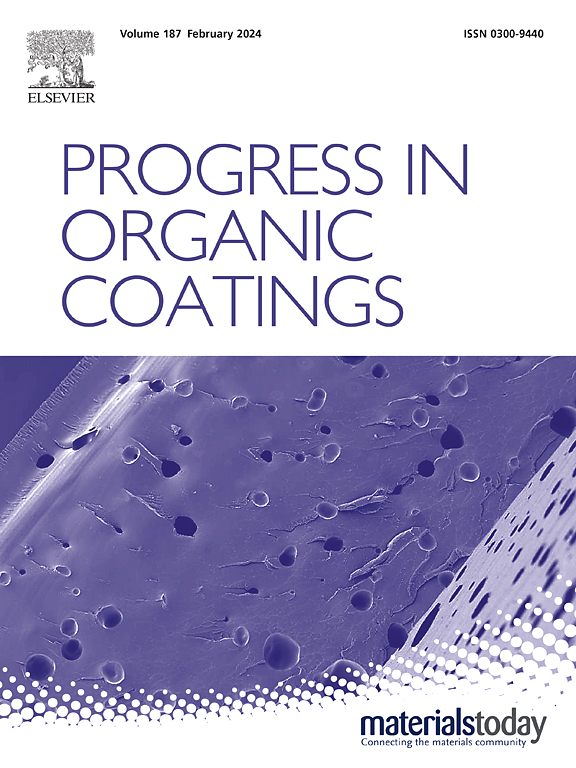Dynamic disulfide-linked vinyl ester nanocomposites for multi-stimuli responsive self-healing anti-corrosion coatings
IF 6.5
2区 材料科学
Q1 CHEMISTRY, APPLIED
引用次数: 0
Abstract
The serious corrosion problems of advanced marine engineering equipment is constraining the implementation of marine potestatem strategy. Graphene modified vinyl ester resin, a new and highly promising composite coating with excellent anti-corrosion, has been widely used in important advance marine equipment. However, their inherent thermosetting cross-linked structures, coupled with the formation of pores and cracks during the curing process, limit their ability to self-heal after mechanical damage, thereby compromising their barrier effectiveness. To address these challenges, this work reports the development of a novel disulfide bond-containing vinyl ester resin by reacting epoxy resin with dithiodipropionic acid. The optimized cured resin exhibits a tensile strength of 50.41 MPa, demonstrates stress relaxation behavior, and possesses physical recyclability at 160 °C under 15 MPa within 30 min, along with heat-induced shape memory properties. Incorporating modified graphene oxide particles into the resin matrix imparts multi-stimuli-responsive self-healing capabilities and introduces a “maze” effect that enhances the coating's protective performance. The resulting composite coatings exhibit efficient scratch healing under various stimuli (i.e., heating, near-infrared (NIR), ultraviolet (UV), and microwave irradiation) and maintain long-term anti-corrosion efficacy, retaining an impedance of 9.38 × 109 Ω cm2 after 120 d of immersion in 3.5 wt% NaCl solution. These findings highlight the potential of this advanced coating system for durable protection in marine environments.

用于多刺激响应自修复防腐涂层的动态二硫键乙烯基酯纳米复合材料
先进海洋工程装备严重的腐蚀问题制约着海洋生态系统战略的实施。石墨烯改性乙烯基酯树脂是一种新型的具有良好防腐性能的复合涂料,已广泛应用于重要的先进船舶装备。然而,它们固有的热固性交联结构,加上在固化过程中形成的孔隙和裂缝,限制了它们在机械损伤后的自愈能力,从而影响了它们的屏障效果。为了解决这些挑战,本工作报道了通过环氧树脂与二硫代二丙酸反应,开发出一种新型含二硫键的乙烯基酯树脂。优化后的固化树脂的抗拉强度为50.41 MPa,具有应力松弛行为,在160°C、15 MPa、30 min内具有物理可回收性,并具有热致形状记忆性能。将改性的氧化石墨烯颗粒加入树脂基体中,赋予了多重刺激响应的自修复能力,并引入了“迷宫”效应,增强了涂层的保护性能。所制备的复合涂层在各种刺激(即加热、近红外、紫外和微波照射)下都能有效地修复划痕,并保持长期的防腐效果,在3.5 wt% NaCl溶液中浸泡120 d后,其阻抗仍保持在9.38 × 109 Ω cm2。这些发现突出了这种先进涂层系统在海洋环境中持久保护的潜力。
本文章由计算机程序翻译,如有差异,请以英文原文为准。
求助全文
约1分钟内获得全文
求助全文
来源期刊

Progress in Organic Coatings
工程技术-材料科学:膜
CiteScore
11.40
自引率
15.20%
发文量
577
审稿时长
48 days
期刊介绍:
The aim of this international journal is to analyse and publicise the progress and current state of knowledge in the field of organic coatings and related materials. The Editors and the Editorial Board members will solicit both review and research papers from academic and industrial scientists who are actively engaged in research and development or, in the case of review papers, have extensive experience in the subject to be reviewed. Unsolicited manuscripts will be accepted if they meet the journal''s requirements. The journal publishes papers dealing with such subjects as:
• Chemical, physical and technological properties of organic coatings and related materials
• Problems and methods of preparation, manufacture and application of these materials
• Performance, testing and analysis.
 求助内容:
求助内容: 应助结果提醒方式:
应助结果提醒方式:


